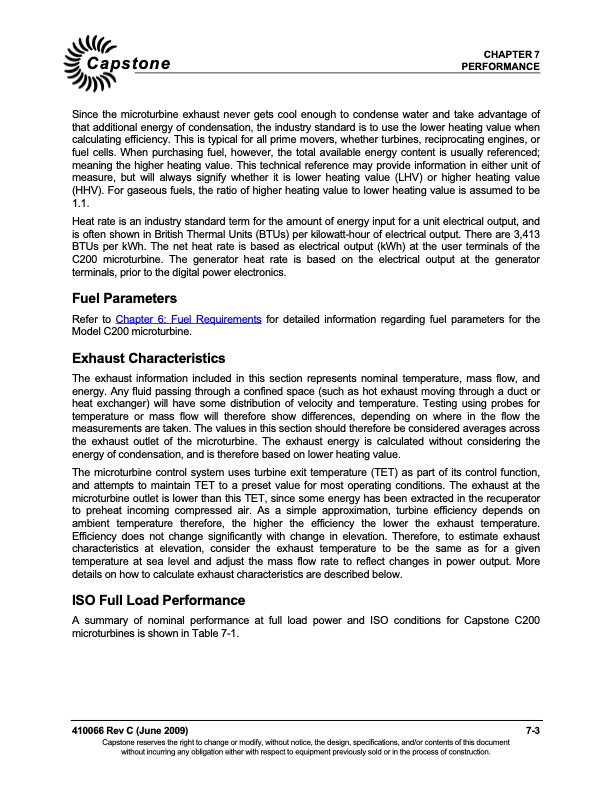
PDF Publication Title:
Text from PDF Page: 051
CHAPTER 7 Capstone PERFORMANCE Since the microturbine exhaust never gets cool enough to condense water and take advantage of that additional energy of condensation, the industry standard is to use the lower heating value when calculating efficiency. This is typical for all prime movers, whether turbines, reciprocating engines, or fuel cells. When purchasing fuel, however, the total available energy content is usually referenced; meaning the higher heating value. This technical reference may provide information in either unit of measure, but will always signify whether it is lower heating value (LHV) or higher heating value (HHV). For gaseous fuels, the ratio of higher heating value to lower heating value is assumed to be 1.1. Heat rate is an industry standard term for the amount of energy input for a unit electrical output, and is often shown in British Thermal Units (BTUs) per kilowatt-hour of electrical output. There are 3,413 BTUs per kWh. The net heat rate is based as electrical output (kWh) at the user terminals of the C200 microturbine. The generator heat rate is based on the electrical output at the generator terminals, prior to the digital power electronics. Fuel Parameters Refer to Chapter 6: Fuel Requirements for detailed information regarding fuel parameters for the Model C200 microturbine. Exhaust Characteristics The exhaust information included in this section represents nominal temperature, mass flow, and energy. Any fluid passing through a confined space (such as hot exhaust moving through a duct or heat exchanger) will have some distribution of velocity and temperature. Testing using probes for temperature or mass flow will therefore show differences, depending on where in the flow the measurements are taken. The values in this section should therefore be considered averages across the exhaust outlet of the microturbine. The exhaust energy is calculated without considering the energy of condensation, and is therefore based on lower heating value. The microturbine control system uses turbine exit temperature (TET) as part of its control function, and attempts to maintain TET to a preset value for most operating conditions. The exhaust at the microturbine outlet is lower than this TET, since some energy has been extracted in the recuperator to preheat incoming compressed air. As a simple approximation, turbine efficiency depends on ambient temperature therefore, the higher the efficiency the lower the exhaust temperature. Efficiency does not change significantly with change in elevation. Therefore, to estimate exhaust characteristics at elevation, consider the exhaust temperature to be the same as for a given temperature at sea level and adjust the mass flow rate to reflect changes in power output. More details on how to calculate exhaust characteristics are described below. ISO Full Load Performance A summary of nominal performance at full load power and ISO conditions for Capstone C200 microturbines is shown in Table 7-1. 410066 Rev C (June 2009) 7-3 Capstone reserves the right to change or modify, without notice, the design, specifications, and/or contents of this document without incurring any obligation either with respect to equipment previously sold or in the process of construction.PDF Image | CAPSTONE C200 MICROTURBINE TECHNICAL REFERENCE

PDF Search Title:
CAPSTONE C200 MICROTURBINE TECHNICAL REFERENCEOriginal File Name Searched:
410066C_C200_Tech_Ref.pdfDIY PDF Search: Google It | Yahoo | Bing
Capstone Turbine and Microturbine: Capstone microturbines used and new surplus for sale listing More Info
Consulting and Strategy Services: Need help with Capstone Turbine, sizing systems, applications, or renewable energy strategy, we are here to assist More Info
Container Lumber Dry Kiln: Since 1991 developing and innovating dry kilns using standard shipping containers More Info
Supercritical CO2 Lumber Dry Kiln: Compact fast drying in 3 days or less for small amounts of wood and lumber drying More Info
BitCoin Mining: Bitcoin Mining and Cryptocurrency... More Info
Publications: Capstone Turbine publications for microturbine and distributed energy More Info
FileMaker Software for Renewable Energy Developing database software for the renewable energy industry More Info
CO2 Gas to Liquids On-Demand Production Cart Developing a supercritical CO2 to alcohol on-demand production system (via Nafion reverse fuel cell) More Info
Stranded Gas for low cost power Bitcoin Mining Using stranded gas for generators may provide breakthrough low power costs for cryptocurrency miners. More Info
| CONTACT TEL: 608-238-6001 Email: greg@globalmicroturbine.com | RSS | AMP |